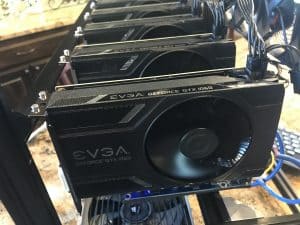Most orders for IN STOCK items placed by 12PM CST M-F ship SAME DAY. Orders for custom items and prints may take additional time to process.

The progression of Bitcoin Mining went like this:
As you can see over time mining power has increased exponentially. An ASIC based miner which costs roughly $2500 today can perform the work of 12,000 PCs which would cost $18 million dollars. The ASIC miner makes far more sense.
It’s super important before we go any further with a discussion of mining Bitcoin with a GPU that we stop and understand how the network size affects mining.
Some are likely to think with more miners on the network more Bitcoins will be mined. This is indeed false. Bitcoin is released at the same rate regardless of network size. Bitcoin has a fixed supply and fixed schedule that is followed. When Bitcoin mining first began, Bitcoins were released at a rate of 50 coins every ten minutes. 50 coins would be released whether there were 10 people mining or 10 million people mining.
Today, just 12.5 Bitcoins are released every ten minutes, but the number of miners has increased 10,000%. To put this in perspective, if ASIC mining were nor a thing there would be ~25 billion CPUs mining Bitcoin today. That’s insanity! So 25 billion CPUs mining only 12.5 bitcoins per ten minutes. Are you ready to put this in perspective? With your desktop PC mining only with your CPU you are 200 times more likely to hit the lottery in your state than you are to ever find a Bitcoin.
Fantastic, but mining Bitcoin with a GPU has to blow that away right? I mean you can put six GPUs in a computer and get the Bitcoin mining equivalent of 180 CPUs. That will dramatically increase my odds. It sure will! You’ve now leveled the playing field! Your just as likely to win your local state lottery as you are to find a Bitcoin. See the problem? To find a Bitcoin you need a LOT more processing power.
Some of you more familiar with mining are saying “Wait a minute Mike, no one solo mines. I don’t need enough power to find a coin on my own! I’ll just mine in a pool and share the rewards.”
This again might sound like the way to go at first. Just toss all of your GPUs into a local mining pool and share the rewards based on the percentage of work your miner submitted.. Mining with a GPU just became profitable again! Well, not so fast. Let’s look at the numbers.
With a GTX 1060 GPU you’ll be capable of about 20 MH/s Bitcoin hashrate. As part of mining pool, your GPU would bring in about $.000112 a day of revenue. The 1060 uses about 95 watts of electricity. With an average electrical cost of 10 cents per kwh. Your total electricity spend would be $6.84 a month. This quite literally puts you $6.84 in the hole every single month.
Let’s face it. Mining Bitcoin with a GPU is not profitable in 2018. Can we stop the madness now?
But wait! There’s more! Hope is not lost for mining with a GPU. There are plenty of alternative coins that can still be mined with a GPU rig. These coins include Ethereum, ZCash, ZCL, and many more. Check out the tour of my Ethereum mining rig and my post on learning to mine Ethereum to learn more. I also did a comparison of the most profitable mining GPUs for 2018.
Hope you have a fantastic 2018 and GPU mine the heck out of those alt-coins!
If you like our content maybe consider upgrading to Premium. You’ll get access to
9 Responses
You can mine bitcoin with a Raspberry Pi in 2018. But you’re never going to find a coin. Ever. There’s a difference between mining and finding a coin. 😉 You can mine with anything.
Then its basically like playing the lottery. I should mine it with my Raspberry Pi. I might hit it big, but I stand to lose nothing!
I suppose, but the chances are tiny. The math says you’d be more likely to get hit by lightning and live, then survive a plane crash, then get electrocuted in your garage and survive that too… only to die on your way to work in a car crash. See how bad your chances are yet?
“There are plenty of alternative coins that can still be mined with a GPU rig.” It’s not that these alt coins are still so “early on” that they are profitable mining with a GPU, it’s that their proof of work algorithms were *specifically designed* to match the architecture of a GPU (not purely computationally intensive, like bitcoin’s sha256, but also very memory intensive) in an attempt to avoid centralization of mining.
Two years later now- is the advice in this article all still valid?
0.5
1.5
4
3.5